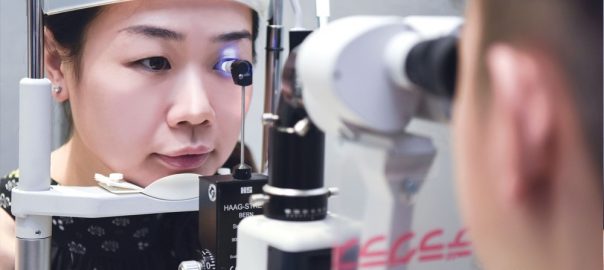Refractive errors occur when light is prevented from focusing directly on the retina, which leads to blurry vision. You may find it difficult to see objects at a certain distance and in severe cases, refractive error can cause visual impairment. You may find more information on the 4 different types of refractive errors and how to manage them below:
Myopia

Myopia, also known as short-sightedness, is a common vision impairment where distant objects may appear blurry, while near objects are clear. Myopia occurs when the eyeball is longer than normal, resulting the light to shift its focus to the front of the retina instead of on the retina itself. Therefore, when light travels into the eyes, the light is not focused properly, thus projecting distant objects blurry. Also, myopia occurs when the cornea is too curved.
Myopia can be discovered from an early age, therefore having regular eye examination is essential for detecting early signs of refractive error to avoid their vision affecting their performance in school. Beside genetics, excessive eye strain especially long hours of exposure in front of digital screens, can also be a risk factor for myopia. This condition can be easily corrected with eyeglasses or contact lens.
Hyperopia

Hyperopia, also known as far-sightedness, is a less common refractive error that allows a person to see distant objects clearly but near objects will appear blurry. As opposed to short sightedness, the eyeball is shorter than normal which cause the light to fall behind of the retina.
In some cases, children who are born far-sighted could lessen their hyperopia as their eyeball lengthens in their natural aging process. Although hyperopia is not preventable, it has to be managed to avoid problems such as headaches, eye strain, discomfort and/or burning sensation on the eyes. Wearing eyeglasses or contact lens is the most common method for correcting hyperopia.
Astigmatism

Astigmatism is commonly associated with other refractive error like myopia and hyperopia. Astigmatism occurs when the clear front surface of your eye is irregularly shaped or mismatched curves on the inside of your eye. Due to the irregular shape, the light is prevented from focusing on the retina, which results vision to be blurry.
Astigmatism can be caused by many factors, such as biological inheritance, eye surgery or injury. However, astigmatism can increase or decrease in time as the curve of lens on the inside of your eye changes.
Presbyopia

Presbyopia is an eye condition that occurs as you get older. The aging of the eye causes it to lose its original flexibility to adjust its shape to focus on near objects. As a result, people with presbyopia would experience difficulty in seeing fine objects or small prints on books and newspaper, unless the reading item is placed at a certain distance.
This condition can be treated by wearing bi-focal eyeglasses or contact lenses. Although this vision condition may be similar to hyperopia, presbyopia would usually affect people after their 40’s and later while hyperopia often occurs from a young age.
We hope that this clarifies the 4 different types of refractive errors of the eye. If you are experiencing blurry vision, it is advisable to visit an eye doctor at the earliest convenience to receive proper treatment.









